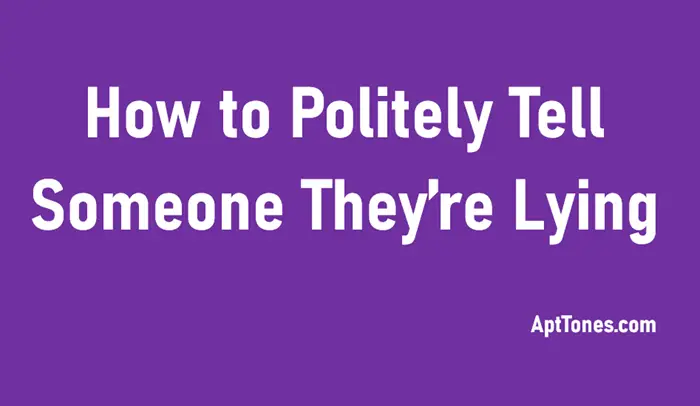Someone just told you something that doesn’t add up. Maybe the details don’t match what you heard before, or the story seems too convenient. Calling out lies is tricky business.
Nobody wants to destroy relationships or create drama. But letting dishonesty slide can hurt you and others down the road. The trick is finding ways to address it without throwing accusations around.
These 20 approaches help you handle those awkward moments when you need to question someone’s honesty. They work whether you’re dealing with colleagues, friends, or anyone else who might be bending the truth.

Polite Ways to Tell Someone They Are Lying
We will explore the appropriateness of each response and the best scenarios to employ them, along with hypothetical dialogues to illustrate their use.
1. Seeking Clarification
“I’m having a bit of trouble understanding your point. Could you please clarify or provide more details to help me better understand?”
This response is appropriate when you suspect misinformation but want to give the person a chance to explain themselves.
Example:
You: “I’m having trouble understanding your point. Could you clarify or provide more details?”
Person: “Sure, let me explain a bit more.”
2. Expressing Doubt
“That’s an interesting point, but it seems to differ from what I’ve previously learned or observed. Could you elaborate on how you arrived at this conclusion?”
Use this approach when their statement conflicts with your knowledge or observations.
Example:
You: “Your point differs from what I know. Could you elaborate on your conclusion?”
Person: “Certainly, let me go into more detail.”
3. Referring to Known Facts
“Based on the facts that we have, it seems like there might be some inconsistencies in what you’re saying. Could we go over this again to ensure accuracy?”
Best used when you can directly refer to facts that contradict their statement.
Example:
You: “There are some inconsistencies with the facts we have. Can we review this for accuracy?”
Person: “Of course, let’s go over it again.”
4. Highlighting Discrepancies
“I noticed that what you’re saying now is different from what you mentioned earlier. Could you help me understand this discrepancy?”
Effective when their current statement contradicts their previous ones.
Example:
You: “What you’re saying now is different from earlier. Can you explain the discrepancy?”
Person: “Let me clarify that for you.”
5. Offering an Out
“Sometimes, we can unintentionally misremember details. Is it possible that there might be a mix-up in what’s being shared?”
Use this to give them a graceful way to correct themselves without direct accusation.
Example:
You: “We can misremember sometimes. Is there a mix-up in the details?”
Person: “You might be right, let me think this through again.”
6. Suggesting a Double Check
“Let’s double-check these details to make sure everything aligns correctly. Sometimes a second look can help clarify things.”
Appropriate when you want to verify the information without directly accusing them of lying.
Example:
You: “Let’s double-check these details for accuracy. A second look might help.”
Person: “Good idea, let’s review it together.”
7. Using Humor
“That’s quite a story! It almost sounds too good to be true. Are you pulling my leg here?”
Using humor can be an effective way to address a lie without creating a confrontational atmosphere.
Example:
You: “That’s quite a story! Are you pulling my leg here?”
Person: “Well, maybe I exaggerated a bit.”
8. Asking for Sources
“Your information is really interesting. Could you share where you got it from? I’d like to read more about it.”
Best used when you suspect the information is fabricated or incorrect.
Example:
You: “Where did you get this information? I’d like to read more about it.”
Person: “Let me find the source for you.”
9. Expressing Concern
“I’m concerned about the accuracy of this information. It’s important for us to be as precise as possible. Let’s go over it together.”
Effective in a professional setting where accuracy is critical.
Example:
You: “I’m concerned about the accuracy of this. Let’s review it together.”
Person: “Sure, let’s ensure everything is correct.”
10. Seeking Consensus
“I’m not sure that everyone here has the same understanding. Maybe we should discuss this further to ensure we’re all on the same page.”
Useful in a group setting where you suspect someone is not being truthful.
Example:
You: “Let’s discuss this further to ensure we’re all on the same page.”
Group: “That sounds like a good idea.”
11. Suggesting Transparency
“In the spirit of transparency, it’s important that we’re all honest with our information. Are we certain that what’s being shared is accurate?”
Best when promoting an open and honest dialogue is essential.
Example:
You: “Let’s be sure we’re being transparent. Is this information accurate?”
Person: “I believe so, but let’s verify to be sure.”
12. Reflecting Back
“When I hear your explanation, it doesn’t quite align with what I understand about the situation. Maybe I’m missing something – can you help me understand?”
Effective in expressing your perspective while inviting them to clarify.
Example:
You: “Your explanation doesn’t quite align with my understanding. Can you help me understand?”
Person: “Sure, let’s try to clear things up.”
13. Prioritizing Honesty
“Honesty is really important in our discussions. If there’s any uncertainty or speculation in what we’re sharing, it’s vital that we acknowledge it.”
Use this to set a precedent for honesty in the conversation.
Example:
You: “Honesty is important. Let’s acknowledge any uncertainty in our discussion.”
Person: “I agree, let’s be clear about what we know and don’t know.”